
British photographer's extraordinary images of American icons... using up to 30,000 U.S. troops
These are the extraordinary pictures of the Statue of Liberty and icons of U.S. history captured on camera by an ingenious British photographer - using up to 30,000 soldiers.
Englishman Arthur S. Mole took the pictures of soldiers returning to America after World War I.
Now the unique collection of the remarkable pictures has been brought together for the first time at the Carl Hammer Gallery, in Chicago, USA.
Arthur S. Mole
STATUE OF LIBERTY: Using 18,000 troops at Camp Dodge, Iowa, this is one of the many photographs taken by British photographer Arthur S. Mole in army camps across the U.S. in 1918
Mole's work was the first to use a unique technique to beat the problem of perspective after he devised a clever way of getting so many soldiers in the pictures.
Taken in 1918, photographers Arthur S. Mole and his American colleague John D. Thomas took the photographs in camps across the U.S.
UNCLE SAM: 19,000 troops, Camp Lee, Virginia and (R) THE LIBERTY BELL: 25,000 men, Camp Dix, New Jersey
Arthur's great nephew Joseph Mole, 70, said the photographer was unique in the way he captured so many people on film.
He said: 'In the picture of the Statue of Liberty there are 12,000 men in the torch alone, but just 17 at the base.
'The men at the top of the picture are actually half a mile away from the men at the bottom.
'Arthur was able to get the image by actually drawing an outline on the lens, he then had the troops place flags in certain positions while he looked through the camera.
Arthur S. Mole
MACHINE GUN INSIGNIA: 22,500 officers and men at Camp Hancock in Augusta. A special 70-foot tower was built at each site especially for the shots
'It worked so well because these men were used to following orders and the flags were a well known way of communicating.
'When it came to the day of the photograph Arthur would then be able to put all the pieces together, he could say to 157 men 'move there and you can be Woodrow Wilson's ear'.
'It would take a week to get all the outlines right, but just 30 minutes to move all the men into position to take the shot, it must have been amazing to watch.'
In total they took a total of 10 photos where thousands of soldiers were posed to form giant living symbols of the USA, including a portrait of president Woodrow Wilson, the Liberty Bell, the Statue of Liberty, the Marine Corps emblem, and more.
Arthur S Mole
THE HUMAN U.S. SHIELD: 30,000 officers assembled in Camp Custer, Battle Creek, Michigan. It would take the photographer weeks to get all the outlines right but just 30 minutes to move all the men into position
The photographs were taken as part of a U.S. government bid to raise public morale.
Carl Hammer, from the Chicago gallery of the same name, said Mole and Thomas were unique for their time.
He said: 'I see modern photographers with all the technology we have these days trying to do the same as these two guys did almost 100 years ago, and I still think they did it best and they did it first.
'It really is very clever how they managed to get so many soldiers in the shots, they realised using the same amount of soldiers for each row they would lose the image in the background.
Arthur S Mole
British photographer Mole, along with his American colleague John D. Thomas, were commissioned to take the photographs by the U.S. government to raise morale among the troops
'If you look at the Statue of Liberty formation there are just a handful of men at the front, but the back row is made of thousands.
'Mole and Thomas were commissioned by the U.S. government to take the pictures as a way to raise morale among the troops and raise money by selling the shots to the public.
'It must have been incredible for the soldiers to be part of these photos and to be part of this slice of history.'
Read more:
EXTRODINARY IMAGES







